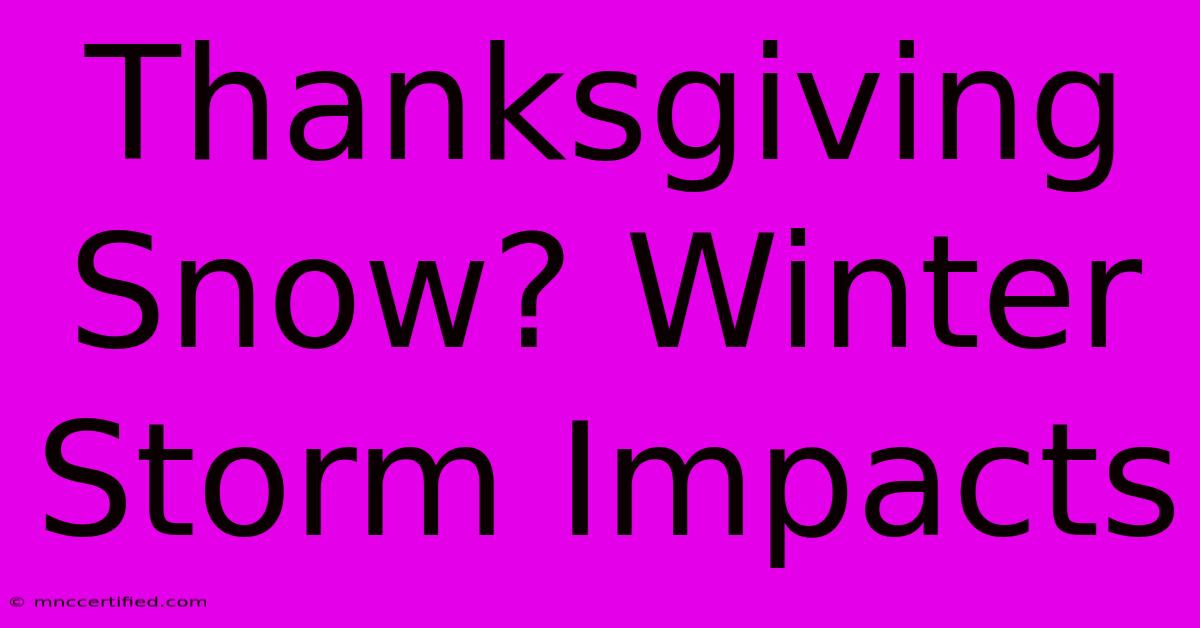Thanksgiving Snow? Winter Storm Impacts

Table of Contents
Thanksgiving Snow? Winter Storm Impacts: A Guide to Preparation and Safety
Thanksgiving is a time for family, feasts, and football – not usually blizzards and freezing rain. However, the possibility of a Thanksgiving winter storm is a very real concern for many across North America. This article delves into the potential impacts of a winter storm during the Thanksgiving holiday, offering crucial advice on preparation and staying safe.
Understanding the Risks of a Thanksgiving Snowstorm
A Thanksgiving snowstorm presents unique challenges. Travel disruptions are the most immediate concern. Millions travel for the holiday, and a major snowstorm can lead to:
- Flight cancellations and delays: Airports across the country can shut down, stranding travelers far from home.
- Hazardous road conditions: Icy roads and reduced visibility make driving extremely dangerous, leading to accidents and traffic jams.
- Power outages: Heavy snow and ice can damage power lines, leaving homes and businesses without electricity, especially problematic during a cold snap.
- Supply chain disruptions: Snowstorms can impact the delivery of food and other essential goods, potentially impacting your Thanksgiving dinner plans.
Specific Risks for Thanksgiving Travelers
Thanksgiving travel is already stressful. Adding a winter storm significantly increases the risk of:
- Being stranded: Unexpected delays and road closures can leave travelers stranded in unfamiliar locations, potentially without access to food, shelter, or communication.
- Missed celebrations: Winter storms can prevent you from reaching your family and friends for Thanksgiving dinner.
- Increased costs: Unexpected accommodation, transportation, and food expenses can significantly impact your budget.
Preparing for a Thanksgiving Winter Storm
Preparation is key to minimizing the risks of a Thanksgiving snowstorm. Here’s a checklist to help you get ready:
- Monitor weather forecasts: Stay updated on weather reports from reliable sources like the National Weather Service (NWS) leading up to and during your travel.
- Pack an emergency kit: Include blankets, extra clothing, non-perishable food, water, a first-aid kit, medications, a flashlight, and a fully charged portable charger.
- Check your vehicle: Ensure your car is in good working condition with plenty of antifreeze, a full tank of gas, and winter tires (if applicable).
- Inform others of your travel plans: Share your itinerary with family and friends, including your expected arrival time and route.
- Prepare your home: Stock up on essential supplies, including food, water, and medications. Consider having a backup power source, like a generator.
Travel Preparations: Don't Get Caught in the Snow!
If you must travel during a winter storm, take extra precautions:
- Allow extra travel time: Expect delays and plan accordingly.
- Drive slowly and cautiously: Reduce speed and increase following distance.
- Be aware of black ice: Black ice is nearly invisible and incredibly dangerous.
- Carry chains or traction devices: These can be essential in snowy or icy conditions.
- Let someone know your route and ETA: Keep in regular contact with someone who isn't traveling with you.
Staying Safe During a Thanksgiving Snowstorm
If you're caught in a snowstorm, prioritize safety:
- Find shelter: If you're stranded, find a safe place to wait out the storm.
- Stay warm: Dress in layers and use blankets to stay warm.
- Conserve energy: Limit your use of electronic devices to conserve battery power.
- Stay informed: Monitor weather reports and emergency alerts.
- Seek assistance if needed: Contact emergency services if you need help.
Conclusion: Thanksgiving Doesn't Have to be a Snow Day Nightmare
While a Thanksgiving snowstorm can be disruptive, proper preparation and awareness can significantly reduce the risks. By following the tips outlined above, you can ensure a safe and enjoyable Thanksgiving holiday, regardless of the weather. Remember to prioritize safety, stay informed, and be prepared for any eventuality. Happy Thanksgiving!

Thank you for visiting our website wich cover about Thanksgiving Snow? Winter Storm Impacts. We hope the information provided has been useful to you. Feel free to contact us if you have any questions or need further assistance. See you next time and dont miss to bookmark.
Featured Posts
-
Car Insurance Same Day Accident
Nov 26, 2024
-
Jon Benet Ramsey Why No Closure
Nov 26, 2024
-
Lauren Laverne Cancer Journey Update
Nov 26, 2024
-
Quincy Mutual Insurance Reviews
Nov 26, 2024
-
Every Copa Libertadores And Ucl Winner
Nov 26, 2024